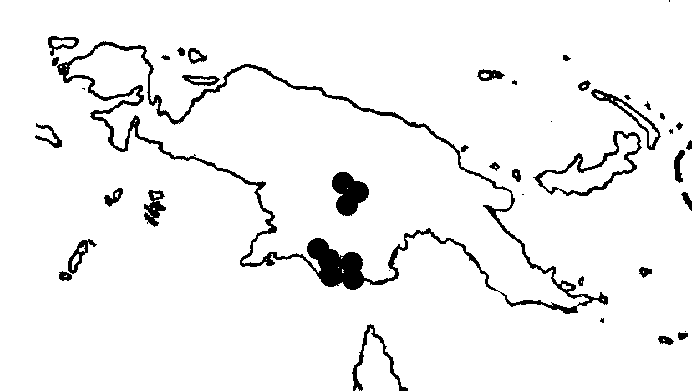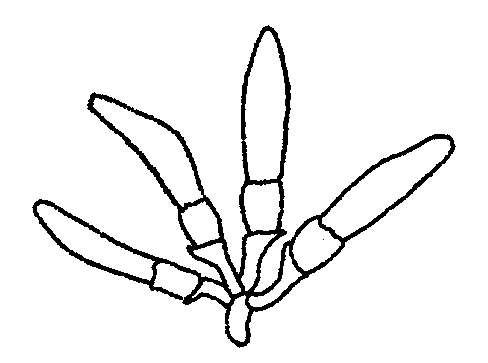
Distribution Map (Barlow 1974)

Description (Barlow 1974)
Dendrophthoe trichanthera Barlow, sp. nov.
Type-New Guinea, Tarara, Wassi-Kussa R., Western District, Brass 8667, Jan. 1937 ([950115613, holotype; L 944355391; LAE 1542).
Partes juvenes et facies foliorum inferiores et inflorescentiae et fibres dense ferru-gineo-tomentosi; filamenta staminum et partes interius tuborum corollarum pilis stellatis albis (vel brunneis) conspersi; cetera glabra. Folia alterna vel dissita; lamina ovata, 3-7 cm longa, 1.5-3.5 cm lata, apice obtusa, penninervia, nervatione facie superiore distincta, costa facie inferiore prominente, basi in petiolum 5-10 mm longum contracta. Inflorescentiae 1-2 in axillis ortae; axis usque ad 1 cm longus, 4-6 fibres praeditus; pedicelli 3-5 mm longi, versus apices dilati; bracteae patulae, rotundatae, 1.5 mm longae, pleruinque apice acuto. Calyx cylindricus, 3-4 mm longus; limbus erectus, truncatus, 1 mm longus. Corolla in alabastro maturo robusta, supra partem inflatam in collum angustata, apice clavata, 25-30 mm longa. Antherae 3 mm longae; pars liberae filamenti c. 5 mm longae. Fructus (ignotus ubi maturus) urceolatus, c. 10 mm longus, apice limbo calycis persistens.
Young parts, undersides of the leaves, inflorescences and flowers densely rusty- tomentose; filaments of the stamens and the inside of the corolla tube sprinkled with white (or brown) stellate hairs; otherwise glabrous. Petiole 5-10 mm long; lamina ovate, 3-7 by 1.5-3.5 cm, contracted at the base, obtuse at the apex; all venation visible on the upper surface and the midrib prominent on the under surface. Inflorescences 1 or 2 in the axils; axis up to 1 cm long, bearing 4-6 flowers; pedicels 3-5 mm long, dilated towards the apex; bracts spreading, rounded but usually with an acuminate tip, 1 5 mm long. Calyx cylindrical, 3-4 mm long; limb erect, truncate, 1 mm long. Corolla in the mature bud robust, narrowed into a neck above the inflated part and clavate at the apex, 25-30 mm long. Anthers 3 mm long; free parts of the filaments c. 5 mm long. Fruits (not seen mature) urceolate, c. 10 mm long, with the calyx limb persistent af the apex. (Fig. 7, j.)
Occurrence. New Guinea, in the southern border areas of West Irian and Papua (Fig. 8), sea level to 300 in altitude.
Representative Specimens. WEST IRIAN: Merauke Dist., near Kp. Senajo, Anta 200, 5.viii.1941 (L). EASTERN NEW GUINEA: Ingembit Village, Kiunga Subdist., Western Dist., 150 m alt., Ridsdale, Henty and Galore NGF 3 1775, 7.vi.1967 (L); Tumbuke, Wassi-Kussa R., Brass 8479, Dec. 1936 (L; LAE).
The specimens cited above differ from the widespread D. falcata in the nature of the indumentum, and especially in the presence of stellate hairs on the filaments of the stamens. Since D. trichanthera and D. falcata are clearly sympatric, the former is treated here as a distinct species. See note under D. falcata.
Danser (1940) referred two of the specimens
cited above to D. gjellerupii. The differences between
D. trichanthera and D. gjellerupii are at least
as great as those between D. trichanthera and D. falcata,
and even on the basis of Danser's own circumscription of D.
gjellerupii it is difficult to see why he included the above
specimens there. See note under D. gjellerupii.
Illustrations

Dendrophthoe trichanthera. Young inflorescence. From Barlow (1974).
Photographs
Dendrophthoe trichanthera
updated 20 January 2007